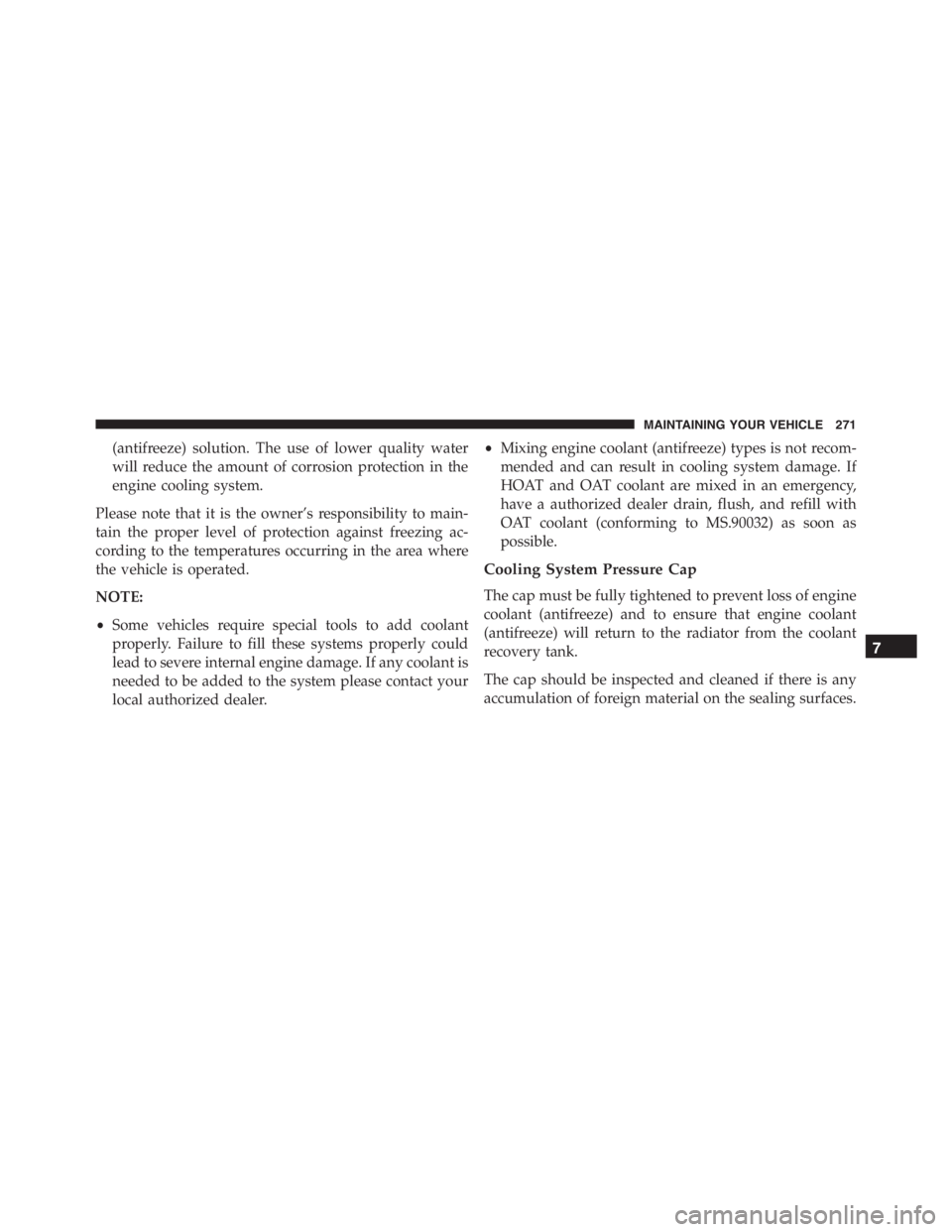Page 273 of 348

(antifreeze) solution. The use of lower quality water
will reduce the amount of corrosion protection in the
engine cooling system.
Please note that it is the owner’s responsibility to main-
tain the proper level of protection against freezing ac-
cording to the temperatures occurring in the area where
the vehicle is operated.
NOTE:
•Some vehicles require special tools to add coolant
properly. Failure to fill these systems properly could
lead to severe internal engine damage. If any coolant is
needed to be added to the system please contact your
local authorized dealer.•Mixing engine coolant (antifreeze) types is not recom-
mended and can result in cooling system damage. If
HOAT and OAT coolant are mixed in an emergency,
have a authorized dealer drain, flush, and refill with
OAT coolant (conforming to MS.90032) as soon as
possible.
Cooling System Pressure Cap
The cap must be fully tightened to prevent loss of engine
coolant (antifreeze) and to ensure that engine coolant
(antifreeze) will return to the radiator from the coolant
recovery tank.
The cap should be inspected and cleaned if there is any
accumulation of foreign material on the sealing surfaces.
7
MAINTAINING YOUR VEHICLE 271
Page 274 of 348

WARNING!
•Do not open hot engine cooling system. Never add
engine coolant (antifreeze) when the engine is
overheated. Do not loosen or remove the cap to cool
an overheated engine. Heat causes pressure to
build up in the cooling system. To prevent scalding
or injury, do not remove the pressure cap while the
system is hot or under pressure.
•Do not use a pressure cap other than the one
specified for your vehicle. Personal injury or en-
gine damage may result.
Disposal Of Used Engine Coolant
Used ethylene glycol-based engine coolant (antifreeze) is
a regulated substance requiring proper disposal. Check
with your local authorities to determine the disposal
rules for your community. To prevent ingestion by ani-
mals or children, do not store ethylene glycol-basedengine coolant in open containers or allow it to remain in
puddles on the ground. If ingested by a child or pet, seek
emergency assistance immediately. Clean up any ground
spills immediately.
Coolant Level
The coolant expansion bottle provides a quick visual
method for determining that the coolant level is ad-
equate. With the engine off and cold, the level of the
engine coolant (antifreeze) in the bottle should be be-
tween the “MIN” and “MAX” marks.
As long as the engine operating temperature is satisfac-
tory, the coolant bottle need only be checked once a
month.
When additional engine coolant (antifreeze) is needed to
maintain the proper level, it should be added to the
coolant bottle. Do not overfill.
272 MAINTAINING YOUR VEHICLE
Page 316 of 348
Change Engine Oil at 4000 miles (6,500 km) if the vehicle
is operated in a dusty and off road environment. This
type of vehicle use is considered Severe Duty.
If the vehicle is operated in a dusty or dirty environment
the engine air filter has to be changed every 6500 miles
(10,000 km).
Once A Month Or Before A Long Trip/Periodic Checks
Every 600 miles (1,000 km) or before long trips, check
and, if necessary, top off the following:
•Check engine oil level
•Check brake fluid level
•Check windshield washer fluid level•Check the tire inflation pressures and look for unusual
wear or damage
•Check the fluid levels of the coolant reservoir and
brake master cylinder reservoir, and add as needed
•Check function of all interior and exterior lights
•Check screen wash/wipe system and positioning/
wear of windscreen
Every 2000 miles (3000 km) check and, if necessary, top
up: engine oil level
314 MAINTENANCE SCHEDULES
Page 319 of 348
Mileage or time passed (whichever comes first)
12,000
24,000
36,000
48,000
60,000
72,000
Or Months: 12 24 36 48 60 72
Or Kilometers:
20,000
40,000
60,000
80,000
100,000
120,000
Check cleanliness of hood and deck lid locks, as well as cleanli-
ness and lubrication of associated linkagesXX X X X X
Visually inspect condition of: exterior bodywork, carbon monocoque,
aerodynamic bottom, pipes and hoses (exhaust, fuel supply system,
brakes), rubber elements (boots, driveshaft boots, sleeves, bushes,
etc.)XX X X X X
Check condition and wear of front brake pads and discs, and op-
eration of pad wear indicatorXX X X X X
Check condition and wear of rear brake pads and discs, and opera-
tion of pad wear indicatorXX X X X X
Check and top off, if required, fluid levels (engine coolant, brake/
hydraulic clutch fluid, windscreen washer fluid, battery fluid, etc)XX X X X X
Visually inspect the condition of accessory drive belt(s) X
8
MAINTENANCE SCHEDULES 317
Page 335 of 348

Brake, Parking...........................173
Brakes.................................274
Brake System............................175
Anti-Lock (ABS)........................178
Master Cylinder........................274
Parking..............................173
Break-In Recommendations, New Vehicle.........68
Bulb Replacement.........................292
Bulbs, Light..............................72
Capacities, Antifreeze (Engine Coolant)..........306
Capacities, Fluid..........................306
Caps, Filler
Oil (Engine)...........................253
Carbon Monoxide Warning...................70
Car Washes.............................281
Cellular Phone...........................142
Chains, Tire.............................208
Chart, Tire Sizing.........................186Checking Your Vehicle For Safety...............69
Checks, Safety............................69
Child Restraint............................57
Clean Air Gasoline........................216
Cleaning
Wheels...............................282
Windshield Wiper Blades..................259
Climate Control..........................143
Manual..............................143
Clutch.................................274
Clutch Fluid.............................274
Compact Spare Tire........................203
Contract, Service..........................324
Coolant (Antifreeze).......................306
Cooling System...........................268
Adding Coolant (Antifreeze)...............270
Coolant Level..........................268
Disposal of Used Coolant.................272
Drain, Flush, and Refill...................268
10
INDEX 333